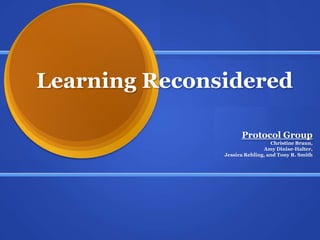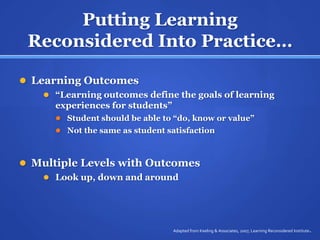Learning Reconsidered Protocol Presentation
- 1. Learning ReconsideredProtocol GroupChristine Braun, Amy Dinise-Halter, Jessica Rehling, and Tony R. Smith
- 2. Why Learning Reconsidered?Opening VideoRefer to page 2 of Learning Reconsidered: Heading - Toward A New Understanding of Students and Learning
- 3. The Four A’sBreak into groups3-4 people per group10 minutes for each question to follow. We will prompt you for time.
- 4. The Four A’s What Assumptions do the authors of the text hold?What do you Agree with in the text?What do you want to Argue with in the text?What parts of the text do you want to Aspire to?
- 5. The Four A’s What Assumptions do the authors of the text hold?What do you Agree with in the text?What do you want to Argue with in the text?What parts of the text do you want to Aspire to?
- 6. Bringing Us Back…Coming back together…
- 7. Putting Learning Reconsidered Into Practice…Learning Outcomes“Learning outcomes define the goals of learning experiences for students”Student should be able to “do, know or value”Not the same as student satisfactionMultiple Levels with OutcomesLook up, down and aroundAdapted from Keeling & Associates, 2007, Learning Reconsidered Institute.
- 8. Outcome-based ThinkingFrom process-based thinking to outcome-based thinkingShift in attention from satisfaction to learningShift from “just doing an activity” to defining what students will learning from the activity and why the activity is important to student learningAdapted from Keeling & Associates, 2007, Learning Reconsidered Institute.
- 9. Writing Learning OutcomesCharacteristics of Good Learning Outcomes:ObservableMeasurableAssessment becomes key to defining and examining student learningAction-orientedAccording to Keeling and Associates learning outcomes should be:Very specificPracticalMeasurableMeaningfulConsistentSensibleCredibleAdapted from Keeling & Associates, 2007, Learning Reconsidered Institute.
- 11. Let’s Practice…Groups: Experiential EducationHigh School to College TransitionsResidential LifeLeadership DevelopmentTransformative Learning
- 12. Let’s Process…What questions do you have?What are the implications to the field? To you?
- 13. What Amazing OpportunitiesClosing Video
- 14. ReferencesBloom, B. S. (1956). Taxonomy of educational objectives, handbook I: The cognitive domain. New York, NY: David McKay.Keeling, R. P. (2007, June). From reconsidering learning to promoting student success: Creating institutional effectiveness [PowerPoint slides]. Retrieved from http://www.keelingassociates.com/ka/presentationsrecent.Kendal,P. L. (1994). The continuing education guide: The CEU and other professional development criteria. Lakeville, MN: Hunt. Retrieved June 18, 2007 from American Association of Law Libraries at http://www.aallnet.org/prodev/outcomes.asp.













![ReferencesBloom, B. S. (1956). Taxonomy of educational objectives, handbook I: The cognitive domain. New York, NY: David McKay.Keeling, R. P. (2007, June). From reconsidering learning to promoting student success: Creating institutional effectiveness [PowerPoint slides]. Retrieved from http://www.keelingassociates.com/ka/presentationsrecent.Kendal,P. L. (1994). The continuing education guide: The CEU and other professional development criteria. Lakeville, MN: Hunt. Retrieved June 18, 2007 from American Association of Law Libraries at http://www.aallnet.org/prodev/outcomes.asp.](https://image.slidesharecdn.com/learningreconsideredprotocolpresentation-12677407678632-phpapp01/85/Learning-Reconsidered-Protocol-Presentation-14-320.jpg)